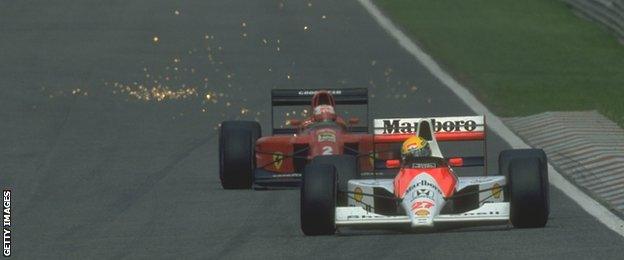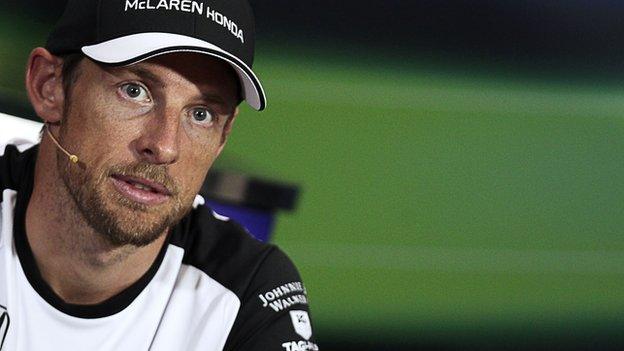David Coulthard: Short-changed drivers not enjoying F1
- Published
From seeing the reaction on social media following the race, I know I am not the only person who did not like what I saw at the Canadian Grand Prix.
The number of radio messages about fuel saving during the race really annoyed me.
It seems to me that this is the biggest issue at the heart of complaints that Formula 1 is not what it should be, in terms of a test of man and machine on the limit at all times.
The sport has gone from the bucking bronco cars driven by Ayrton Senna, Alain Prost and Nigel Mansell, to an exercise in systems management which Fernando Alonso likened to piloting airliners.
The bigger picture
The sad reality is that the drivers are not enjoying the current F1. They are just not tested sufficiently.
Of course, the cars are hard to drive. They remain the fastest and most sophisticated racing cars in the world.
But they are not difficult enough - either physically or mentally.
Fernando Alonso is an all-time great, a driver who would have been at the top of the sport in whatever era he raced. In the last two races he has said two things that really hit home.
The first was that the last time he was tested to his limit mentally and physically in a grand prix was 10 years ago.
The second was that driving the current cars is more about systems management than it is about driving skill.
Lewis Hamilton is of the same calibre. He said after the race in Canada that he was not even stressed, that it was not difficult.
The essence of F1 is key to success

F1 has lost the physical and mental challenges posed by driving in the era of Senna, Mansell and Prost
Of course, drivers do not have all the answers. But if you are not challenging the best guys, you are short-changing both them and the audience.
I remember getting out of my car in Montreal one year and struggling to see because I was so dehydrated.
The sort of thing we saw in Canada last weekend was more like the challenge traditionally posed by endurance racing.
F1 has to be sexy and have a frisson of danger. At the moment, it is in danger of losing that aspect.
It is no secret that in some countries F1 is losing its audience. I can't believe that is a coincidence.
You don't want drivers to be managing software systems, being engineers in the car and worrying constantly about managing fuel and tyres.
Look back 30 years, to the era of Senna, Prost and Mansell and the cars were bucking broncos that took the drivers to their physical limits and sometimes beyond, admittedly at a time when fitness was not the science it is now.
Even in my era, when sports science began to come into its own, you woke up on race morning thinking: "Thank God I slept well. I can take this challenge today."
You could not stay up until midnight and then go and drive a grand prix. If you did, you would lose concentration and crash.
Now, I know of drivers going from sponsor functions to hang out at parties on the night before a race. Of course, they're not drinking or anything, but it just goes to show how little stress they have about doing a grand prix.
The problem is that F1 is a complicated sport,, external and this is a complicated subject. So let's explain some of that stuff before I go into what I think needs to be changed.
Fuel-saving is an unavoidable fact
Drivers managing brakes and tyres has always been part of the essence of F1 - and fuel has always been a factor in the start-weight of a car, whether or not there was a restriction on fuel usage, as there is now.
The latest F1 rules,, external which included a limit both on the total amount of fuel that can be used during a race and the rate at which it can flow, were introduced last year.
But in the years immediately preceding them, following the banning of refuelling at the end of 2009, teams would always start the races with the cars containing less fuel than would be needed to get to the end of the race driving flat out.
That's because it is faster to start with a lighter car and do a degree of fuel saving through a race, than it is to drive a heavier car flat out.
What are the fuel rules? |
|---|
Cars cannot use more than 100kg of fuel per race |
Fuel flow must not exceed 100kg per hour |
No refuelling mid-race |
Cars can be topped up in other sessions at a rate of 0.8 litres per second |
That is an immutable fact regardless of whether you have deliberately fragile tyres as F1 uses now, or durable, consistent ones, as was the case before the Pirelli era.
Because of this, teams are even this year often starting races with less fuel in their tanks than the maximum allowance of 100kg.
I don't believe that was the case in Canada, which is one of the tracks with the heaviest fuel consumption.
But nevertheless this is a remarkable testament to the technology contained within these turbo hybrid engines, which are now doing races on less than two-thirds of the amount of fuel that was routinely used only two years ago.
Having said all of that, the degree of fuel-saving being done at the moment seems to me to be too much.
Alonso makes a good point
F1 had refuelling throughout my career. Even so, there were races when you under-fuelled the car because it was quicker.
But if we were asked to save fuel it was not by the method used now, which is called 'lift and coast' and involves a driver lifting off the throttle for a period of time before braking for the corner. We usually did it by short-shifting - changing gear before we reached maximum revs.
In other words, it did not affect your driving in the corners, which is the essence of an F1 driver's skill.
There were occasional races when we might lift and coast, but it was not commonplace and it did not affect the racing as it did in Canada.
Back then, to have had a driver come on the radio, as Alonso did on Sunday, and say "let me race, we look like amateurs", would have been unthinkable.
Fundamental change is needed
Max Mosley calls for F1 cost cap
The sport's bosses have agreed to make changes for 2017 that will make the cars five or six seconds a lap faster. That will certainly make a difference in making the cars more challenging.
It's a good first step. But they need to think a bit more deeply about what they really need to do.
After Canada, people were talking about the need to turn grands prix back into flat-out sprints. It's a laudable aim.
But at the same time, we all know that Bernie Ecclestone wants Pirelli to remain as the tyre supplier into a new contract starting in 2017.
If the tyres remain the same as they are now, sprint races are impossible, no matter what you do to the cars.
That's because the tyres simply fall apart if drivers push flat-out for more than a couple of laps. No matter how hard these current tyres produced by Pirelli are, they need managing over a race stint.
But what change?
Ask 10 people and you'll get 10 different answers. Personally, I thought the refuelling era was great, because the cars were fast and demanding and the drivers were on the limit all the time.
But at the same time it is hard to argue with the facts. From 2009 to 2010, when nothing had changed other than the fact that refuelling had been banned - Pirelli and the DRS overtaking aid had not yet been introduced - the number of on-track overtakes more than doubled year-on-year.
That is a compelling argument against refuelling, however much I might like to see it return.
One positive aspect there definitely was to refuelling, though, was that we used to qualify with the amount of fuel with which we would start the race. And that led to different strategies, which in turn led to place changes, even if they were not on the track.
By contrast, right now, if you line the cars up in the order of fastest first and then set them off, it should not be a massive surprise if there is then not an awful lot of overtaking at the front of the field.
It seems to me that F1 has drifted too far from what made it great in the first place.
Sports such as football have remained relatively unchanged and their appeal has passed from generation to generation.
F1 has become too close to the category immediately below it, GP2, so it is too easy for drivers to make the transition, which in turn diminishes the appeal of the star names, whose greater ability has in the past differentiated them from the norm more easily than it can now.
F1 has to project the sense that you are watching a feat of amazing human skill.
It's terrific that the sport's bosses recognise there is a problem and are considering making some changes. But even then they are not going far enough.
They need to have a more fundamental think about what F1 should be, take the time to do it properly and act on that. Half-measures are not enough.
The core appeal of F1 is the gladiatorial aspect of man and machine on the absolute limit at incredible speeds, with the risk - however remote and undesired - that someone could get hurt.
Stray too far from that, and the sport will lose its wow factor.
David Coulthard was talking to BBC Sport's Andrew Benson
- Published21 May 2015

- Published9 June 2015

- Published21 May 2015

- Published18 December 2015

- Published2 November 2018

- Published26 February 2019
